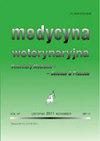Forensic veterinary use of the fly Lucilia sericata (Diptera: Calliphoridae) in the aspect of determining the time of death using tissues treated with calcium diclofenac
IF 0.4
4区 农林科学
Q4 VETERINARY SCIENCES
Medycyna Weterynaryjna-Veterinary Medicine-Science and Practice
Pub Date : 2023-01-01
DOI:10.21521/mw.6752
引用次数: 0
Abstract
Non-steroid anti-inflammatory drugs are commonly used both in medicine and veterinary medicine. The aim of the paper was to determine the effect of diclofenac calcium, the active ingredient of a medicine called diclofenac, on the development rate and survivorship of the fly Lucilia sericata (Meigen, 1826) (Diptera: Calliphoridae). Diclofenac was used at three concentrations: it was mixed with pork meat in proportions 25 mg of the drug 23 g of meat (dose 1), 50 mg/23 g (dose 2) and 75 mg/23 g (dose 3). To compare the results, a control sample was used (23 g of drug-free meat). All diclofenac calcium doses delayed the development of L. sericata. Moreover, all the drug doses (25 mg, 50 mg, 75 mg) resulted in body weight loss of L. sericata larvae. Finally, all the drug doses increased the mortality of L. sericata. The findings indicate that forensic entomology and forensic veterinary analyses involving L. sericata need to take into account a potential factor modifying the fly natural life cycle – the presence of diclofenac calcium in the body. A reduction of the body mass and a longer, than normal developmental cycle of L. sericata may be of significant in correctly determining the time of death of humans or animals in cases of diclofenac application.用双氯芬酸钙处理的组织确定死亡时间的法医兽医应用绢绿蝇(双翅目:绢绿蝇科)
非甾体抗炎药在医学和兽医学中都是常用的。本文的目的是确定双氯芬酸钙(一种叫做双氯芬酸的药物的有效成分)对丝光Lucilia sericata (Meigen, 1826)(双翅目:蝇科)的发育率和存活率的影响。双氯芬酸以三种浓度使用:将其与猪肉混合,比例为25mg / 23g肉(剂量1),50mg / 23g(剂量2)和75mg / 23g(剂量3)。为了比较结果,使用对照样品(23g无药肉)。所有双氯芬酸钙剂量均延迟丝状乳杆菌的发育。25 mg、50 mg、75 mg的剂量均可使丝光l.s icicata幼虫体重下降。最后,所有药物剂量均增加了丝毛l.s icicata的死亡率。研究结果表明,涉及绢毛蝇的法医昆虫学和法医兽医分析需要考虑到改变蝇自然生命周期的潜在因素-双氯芬酸钙在体内的存在。在双氯芬酸应用的情况下,丝毛单胞菌的体重减少和比正常发育周期更长的发育周期可能对正确确定人类或动物的死亡时间具有重要意义。
本文章由计算机程序翻译,如有差异,请以英文原文为准。
求助全文
约1分钟内获得全文
求助全文
来源期刊

Medycyna Weterynaryjna-Veterinary Medicine-Science and Practice
VETERINARY SCIENCES-
CiteScore
0.80
自引率
0.00%
发文量
73
审稿时长
4-8 weeks
期刊介绍:
"Medycyna Weterynaryjna" publishes various types of articles which are grouped in the following editorial categories: reviews, original studies, scientific and professional problems, the history of veterinary medicine, posthumous memoirs, as well as chronicles that briefly relate scientific advances and developments in the veterinary profession and medicine. The most important are the first two categories, which are published with short summaries in English. Moreover, from 2001 the editors of "Medycyna Weterynaryjna", bearing in mind market demands, has also started publishing entire works in English. Since 2008 the periodical has appeared in an electronic version. The following are available in this version: summaries of studies published from 1999 to 2005, full versions of all the studies published in the years 2006-2011 (in pdf files), and full versions of the English studies published in the current year (pdf). Only summaries of the remaining studies from the current year are available. In accordance with the principles accepted by the editors, the full versions of these texts will not be made available until next year.
All articles are evaluated twice by leading Polish scientists and professionals before they are considered for publication. For years now "Medycyna Weterynaryjna" has maintained a high standard thanks to this system. The review articles are actually succinct monographs dealing with specific scientific and professional problems that are based on the most recent findings. Original works have a particular value, since they present research carried out in Polish and international scientific centers.
 求助内容:
求助内容: 应助结果提醒方式:
应助结果提醒方式:


